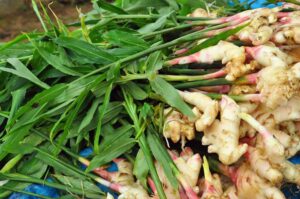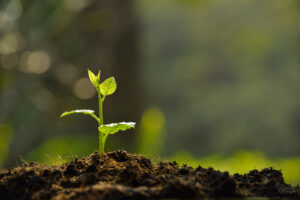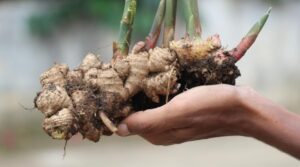Table of Contents

You might assume a lot about the ginger plant’s appearance, but you’re only half-right. You don’t know many things about it; we’ll tell you all about them.
Ginger originates from tropical rainforests but today is grown in many parts. It would be best if you had a question, “What does the ginger plant look like?” it’s probably the thing you want to know before you grow it. Here are some pictures and illustrations that give you an idea of what a ginger plant looks like at various stages of growth and development.
This can help you understand what your ginger plant looks like from when it first sprouts until it matures as an adult, plus some information about how a ginger plant can take care of itself by itself, knowing that all you need to do is to place it in the soil with water, sunlight and wait for it to grow bigger.
Ginger Plant Characteristics
Ginger plants (Zingiberaceae family) are known for their distinctive and attractive characteristics. Understanding these features can help identify ginger plant species, guide their cultivation, and appreciate their beauty.
Here are the key characteristics of ginger plants:
Size and Structure of Ginger Plant
Height range of ginger plants: Ginger plants can vary in height, typically from 1 to 4 feet (30 to 120 centimeters), although some species can grow taller.
Structure of the plant: Ginger plants have upright or sprawling growth habits, depending on the species. They often feature dense clumps of stems from rhizomes (underground stems).
Presence of pseudostems: Ginger plants have pseudostems, which are erect, leafy stems that emerge from the rhizomes. These pseudostems provide support for the leaves and flowers.
Leaf and Stem Features
Leaf shape, size, and arrangement: Ginger plant leaves are typically elongated and lance-shaped, with a pointed tip. The size of the leaves can range from narrow to broad, depending on the species. They are arranged alternately along the stems.
Leaf color and texture: Ginger plant leaves exhibit various shades of green, ranging from light to dark. Some species may have variegated foliage with patterns of different colors. The leaves are generally smooth, but some species may have slightly textured or hairy leaves.
Stem color, texture, and pattern: Ginger plant stems can vary in color, including shades of green, red, or yellow. The stems are usually cylindrical and smooth, while some species may have ridges or patterns.
Inflorescence and Flowers
Description of the inflorescence structure: Ginger plants produce inflorescences known as spikes or racemes. These are long, cone-shaped structures of many individual flowers arranged closely together.
Flower appearance: Ginger flowers are striking and come in various colors, including white, yellow, pink, red, and orange. They typically have a tubular shape with a petal-like structure, often with a contrasting color pattern or markings.
Fragrance and ornamental value of ginger flowers: Many ginger species produce flowers with a delightful fragrance. These flowers are highly ornamental and can add a touch of beauty and elegance to gardens or floral arrangements.
Rhizomes and Root System
Ginger plants have rhizomes, modified underground stems that store nutrients and energy. These rhizomes give rise to new shoots and roots.
Rhizome color, texture, and size: Ginger rhizomes are typically light brown or beige, with a fibrous texture. The size of the rhizomes can vary depending on the species and age of the plant.
Importance of the root system for nutrient absorption: Ginger plants have a well-developed root system that absorbs water and nutrients from the soil to support their growth and health.
Variations in Ginger Plant Characteristics
Different species and varieties of ginger plants: There is a wide range of ginger plant species and varieties, each with unique characteristics.
Notable variations in size, leaf, and flower characteristics: Different ginger plant species exhibit variations in terms of height, leaf shape and size, stem color and texture, as well as flower color and shape.
Geographical influences on ginger plant traits: Ginger plants native to different regions may display specific characteristics influenced by climate, soil conditions, and natural adaptations.
Worldwide Production Of Ginger Plant
Ginger plants grow best with consistent temperatures between 65°F and 75°F (18°C – 24°C) during the day and 55°F – 65°F (13°C – 18°C) at night. They should be fertilized every two weeks while they are growing by adding fertilizer pellets directly into the soil around each plant’s roots.
In 2019, the production of ginger was 4.1 million tonnes, with India with 44% of the world total. Nigeria, China, and Nepal also produce ginger.
Here are some top ginger-producing countries based on historical data up until my knowledge cutoff in September 2021.
| Please note that the percentages may have changed since then. |
Here are some of the leading ginger-producing countries and their approximate production percentages:
| Country | Percentage |
| China | Approximately 28-30% |
| India | Approximately 25-27% |
| Nigeria | Approximately 8-10% |
| Thailand | Approximately 6-8% |
| Indonesia | Approximately 5-7% |
| Nepal | Approximately 3-5% |
| Bangladesh | Approximately 3-5% |
| Philippines | Approximately 2-4% |
| Vietnam | Approximately 2-4% |
| Brazil | Approximately 2-4% |
Structure of Ginger Plants – Unveiling the Intricacies of Rhizomes, Stalks, and Leaves

Here’s an explanation of the structure of ginger plants, highlighting the intricacies of its rhizomes, stalks, and leaves:
- Rhizomes: The rhizome is the underground stem of the ginger plant. It is the most distinctive and valuable plant part, used for culinary and medicinal purposes. The rhizome is typically thick and knobby, with a pale yellow to beige outer skin and yellowish flesh inside. It comprises multiple nodes and internodes, which give rise to shoots and roots.
- Shoots and Stalks: From the rhizome, ginger plants produce shoots that emerge above the ground. These shoots develop into tall stalks known as pseudostems. The pseudostem is a thick, erect structure that resembles a stem but is formed by tightly rolled leaf sheaths. It can grow to about 1 to 1.5 meters (3 to 5 feet).
- Leaves: Ginger plants have long, lance-shaped leaves that emerge from the pseudostem. The leaves are alternate, meaning they are arranged singly along the stalk and not directly opposite each other. They have a deep green color and prominent veins. Ginger leaves can reach lengths of approximately 15-30 centimeters (6-12 inches) and contribute to the overall aesthetic appeal of the plant.
- Inflorescence: In certain conditions, ginger plants produce inflorescences, clusters of flowers. The inflorescence of ginger is known as a spike or an inflorescence cone. It consists of bracts, which are modified leaves that protect the flowers. The bracts are usually green or reddish and can be quite showy. However, ginger is primarily cultivated for its rhizomes rather than its flowers.
- Roots: Beneath the rhizome, ginger plants develop a network of fine, fibrous roots. These roots aid in absorbing water and nutrients from the soil, supporting the growth and overall health of the plant. The roots also play a role in anchoring the ginger plant in the ground.

How to Maintain Ginger Plants?
Maintaining ginger plants involves providing the right growing conditions, regular care, and appropriate cultivation practices. Here’s a step-by-step guide on how to maintain ginger plants:
-
- Planting: Select a suitable location with partial shade or filtered sunlight for planting ginger. Ensure the soil is rich, well-draining, and loose. Ginger prefers warm and humid climates. Plant ginger rhizomes about 2 to 4 inches deep with the buds facing upward.
- Watering: Keep the soil consistently moist but not waterlogged—water ginger plants regularly, especially during dry periods. Avoid overwatering, as excessive moisture can lead to root rot. Mulching around the plants can help retain moisture and regulate soil temperature.
- Fertilizing: Apply a balanced organic fertilizer or compost to the soil before planting. Additionally, provide a diluted liquid fertilizer every few weeks during the growing season to promote healthy growth. Follow the instructions on the fertilizer package for appropriate dosage and application.
- Weed Control: Regularly remove weeds around the ginger plants to prevent competition for nutrients and water. Use hand weeding or shallow cultivation to avoid damaging the shallow roots.
- Pest and Disease Control: Monitor the plants for signs of pests or diseases such as aphids, root rot, or fungal infections. Use organic pest control methods, such as spraying insecticidal soap or neem oil when necessary. Proper plant spacing, airflow, and well-drained soil can help prevent disease issues.
- Harvesting: Ginger plants are typically harvested when the leaves and stalks start to wither and turn yellow. This usually occurs around 8-10 months after planting. Gently dig up the rhizomes, being careful not to damage them. Leave a few rhizomes in the ground to continue growing for future harvests.
- Storage: After harvesting, gently clean off the soil from the rhizomes and allow them to dry for a few days. Store ginger rhizomes in a cool, dry place with good ventilation. You can also freeze or preserve ginger by slicing or grating it and placing it in airtight containers.
When caring for your ginger plant, it’s important to be aware of the potential threat Creeping Charlie poses. This invasive weed can harm your plant and impede its growth. To ensure the well-being of your ginger plant, it is crucial to educate yourself on effective methods for addressing this issue. Learn how to kill Creeping Charlie and safeguard your ginger plant’s health and development.
Popular Ginger Plant Varieties
Ginger plants encompass a diverse range of species and varieties, each with its unique characteristics and uses. Here are some popular ginger plant varieties:
Zingiber officinale (Common Ginger)
- Zingiber officinale, commonly known as common ginger, is the most widely cultivated ginger variety.
- It features tall, slender stems, lance-shaped leaves, and green or yellowish flowers.
- The rhizomes of common ginger are aromatic and commonly used in culinary applications, such as cooking, baking, and brewing ginger tea.
- Common ginger is also known for its medicinal properties and is used in traditional herbal remedies.
Alpinia galanga (Greater Galangal)
- Alpinia galanga, or greater galangal or Thai ginger, is a perennial ginger variety native to Southeast Asia.
- It has broad, deep green leaves and produces spikes of white or pinkish flowers.
- The rhizomes of greater galangal have an intense, spicy flavor and are widely used in Southeast Asian cuisine, particularly Thai, Indonesian, and Malaysian dishes.
- It is a popular ingredient in curry pastes, soups, and traditional herbal medicines.
Hedychium coronarium (White Ginger Lily)
- Hedychium coronarium, commonly called white ginger lily or butterfly ginger, is a tropical ginger species known for its attractive white flowers.
- The plant features long, lance-shaped leaves and tall, upright stems.
- The white ginger lily produces large, fragrant flowers with a distinctively sweet scent.
- It is often grown for ornamental purposes and is prized for its elegant and fragrant blooms.
Curcuma longa (Turmeric)
- Curcuma longa, commonly known as turmeric, is a member of the ginger family.
- It has broad, oblong leaves and produces spikes of yellow flowers.
- The rhizomes of turmeric are bright orange-yellow and contain the active compound curcumin, which gives it a vibrant color and various health benefits.
- Turmeric is widely used in cooking, particularly in Indian and Southeast Asian cuisines. It is also valued for its medicinal properties and is a popular ingredient in traditional Ayurvedic medicine.
Cultivation Tips for Ginger Plants

Cultivating ginger plants successfully requires attention to certain key factors. Here are some essential cultivation tips to help you grow healthy ginger plants:
Light and Temperature Requirements
- Ginger plants thrive in warm and humid environments. They prefer partial shade to filtered sunlight, as direct sunlight can scorch their leaves.
- Optimal temperature ranges for ginger cultivation are between 70°F and 90°F (21°C to 32°C).
- Protect ginger plants from cold drafts and temperatures below 50°F (10°C), as they are sensitive to cold and frost.
Soil Type and pH Preferences
- Ginger plants prefer well-draining, loamy soil that is rich in organic matter.
- The ideal soil pH range for ginger cultivation is slightly acidic to neutral, between 6.0 and 7.0.
- Consider adding compost or well-rotted manure to improve soil fertility and structure.
Watering and Humidity Needs
- Keep the soil moist but not waterlogged, as ginger plants prefer moist conditions.
- Water the plants deeply, ensuring the water reaches the root zone. Avoid overwatering, as it can lead to root rot.
- Maintaining a humid environment is beneficial for ginger plants. Consider using a humidifier or misting the leaves regularly, especially in drier climates.
Propagation Methods
- Ginger plants are commonly propagated using rhizomes. Choose fresh and healthy rhizomes for planting.
- Before planting, soak the rhizomes in water overnight to stimulate growth.
- Plant the rhizomes in a shallow trench with the buds facing up, about 2 to 4 inches (5 to 10 cm) deep and 8 to 12 inches (20 to 30 cm) apart.
Mulching and Weed Control
- Apply a layer of organic mulch, such as straw or wood chips, around ginger plants to help retain moisture, suppress weed growth, and regulate soil temperature.
- Regularly remove weeds around the plants to prevent competition for nutrients and water.
Maintenance and Fertilization
- Keep the area around the ginger plants free from debris and fallen leaves.
- Feed ginger plants with a balanced organic fertilizer or compost every few months to provide necessary nutrients.
- Monitor the plants for pests and diseases, such as aphids or fungal infections, and take appropriate measures for control.
Harvesting Ginger
- Ginger plants take about 8 to 10 months to reach maturity.
- Harvest ginger rhizomes when the leaves begin to turn yellow and die back.
- Gently dig around the rhizomes, being careful not to damage them. Harvest the desired amount and leave some rhizomes in the ground for regrowth.
Ginger Plant Facts
Ginger plants belong to the Zingiberaceae family, which encompasses various species of flowering plants. The most well-known and commonly cultivated ginger plant is Zingiber officinale. It is a perennial herbaceous plant that originated in Southeast Asia and is now grown in tropical and subtropical regions worldwide. Ginger plants are characterized by their thick, fleshy underground stems called rhizomes, which are part of the plant used for culinary and medicinal purposes.
Cultivation and Geographic Distribution of Ginger Plant
Ginger plants thrive in warm and humid climates, preferring temperatures between 20 to 30 degrees Celsius (68 to 86 degrees Fahrenheit). They require well-draining soil enriched with organic matter and are often grown in tropical regions such as India, China, Indonesia, Nigeria, and Jamaica. However, ginger plants can also be cultivated in controlled environments like greenhouses or as potted plants indoors in cooler regions.
Importance and Uses of Ginger Plants
Ginger plants hold significant cultural, culinary, and medicinal value. The rhizomes of ginger plants are widely used as a spice and flavoring agent in various cuisines worldwide. They add a unique, warm, and slightly spicy flavor to dishes and beverages. Additionally, ginger has been used in traditional medicine for centuries due to its potential health benefits, including anti-inflammatory and digestive properties. Ginger plants also have ornamental value, with their attractive foliage and striking flowers often used in landscaping and flower arrangements.
Medicinal Properties and Health Benefits of Ginger
Anti-inflammatory properties: Ginger contains potent anti-inflammatory compounds called gingerols, which can help reduce inflammation in the body. This property makes ginger beneficial for managing conditions like osteoarthritis, rheumatoid arthritis, and other inflammatory disorders.
Digestive aid: Ginger has long been used to alleviate digestive issues such as indigestion, bloating, and nausea. It stimulates the production of digestive enzymes, improves gastrointestinal motility, and helps relieve symptoms of gastrointestinal discomfort.
Nausea and morning sickness relief: Ginger has effectively reduced nausea and vomiting, particularly in motion sickness, pregnancy-related morning sickness, and chemotherapy-induced nausea. It is often recommended as a natural remedy for these conditions.
Pain relief: Due to its anti-inflammatory properties, ginger can help alleviate pain associated with muscle soreness, menstrual cramps, and migraines. It may have a mild analgesic effect and can be used as an adjunct therapy for pain management.
Immune system support: Ginger possesses immune-boosting properties and can help strengthen the immune system. It contains antioxidants that protect against oxidative stress and may help prevent the onset of certain diseases.
Anti-nausea and anti-inflammatory effects in chemotherapy: Some studies suggest that ginger may help reduce chemotherapy-induced nausea and vomiting, making it a valuable supportive therapy for cancer patients undergoing treatment.
Blood sugar regulation: Research indicates ginger may help regulate blood sugar levels and improve insulin sensitivity. This makes it potentially beneficial for individuals with diabetes or those at risk of developing the condition.
Cardiovascular health: Ginger may have positive effects on cardiovascular health by lowering blood pressure and reducing cholesterol levels. These properties contribute to a reduced risk of heart disease and stroke.
Antimicrobial properties: Ginger exhibits antimicrobial activity against certain bacteria and fungi, which may help fight infections and promote overall health.
Ginger Plant Resemblances
The ginger plant looks like celery and grows in tropical areas around the globe. What does a ginger plant look like? Depending on the variety of ginger you are looking at and the size of the root/rhizome you see. Ginger plants have reddish-brown stalks, leaves, and flowers like what we would find on a forest plant (e.g., rosemary or thyme).
| Plant Name | Resemblances with Ginger | Nutritious Properties Similar to Ginger |
| Turmeric | Rhizomatous growth habit | Anti-inflammatory properties, antioxidant content |
| Galangal | Rhizomatous growth habit | Digestive aid, anti-inflammatory properties |
| Cardamom | Similar leaf structure | Digestive aid, antioxidant content |
| Tumeric | Rhizomatous growth habit | Anti-inflammatory properties, antioxidant content |
| Galangal | Rhizomatous growth habit | Digestive aid, anti-inflammatory properties |
| Cardamom | Similar leaf structure | Digestive aid, the antioxidant content |
| Garlic | Bulbous growth habit | Cardiovascular benefits, immune system support |
| Onion | Bulbous growth habit | Antioxidant content, potential anti-cancer properties |
| Cinnamon | Aromatic and spicy flavor | Blood sugar regulation, anti-inflammatory properties |
| Cloves | Aromatic and spicy flavor | Antioxidant content, digestive aid |
FAQs
How do I grow ginger plants?
A: To grow ginger plants, obtain fresh and healthy ginger rhizomes. Soak the rhizomes overnight, plant them in well-draining soil with the buds facing up, and keep the soil consistently moist. Provide partial shade, maintain a warm temperature (70°F to 90°F), and fertilize regularly. Harvest ginger rhizomes when the leaves turn yellow.
What are the ideal growing conditions for ginger plants?
A: Ginger plants prefer partial shade to filtered sunlight and well-draining, loamy soil rich in organic matter. The optimal temperature range for growth is between 70°F and 90°F. Maintain a humid environment and protect the plants from temperatures below 50°F.
How long does it take for ginger plants to mature?
A: Ginger plants typically take about 8 to 10 months to reach maturity. The duration may vary based on the ginger variety, growing conditions, and climate.
Can I grow ginger plants indoors or in containers?
A: Yes, ginger plants can be grown indoors or in containers. Choose a large pot with good drainage, use well-draining soil, and place it in a warm and bright location. Indoor ginger plants may require additional humidity through misting or a humidifier.
What are the culinary uses of ginger?
A: Ginger is a versatile spice used in various culinary applications. It adds a distinct flavor and aroma to dishes, including stir-fries, curries, soups, marinades, baked goods, and beverages like ginger tea or ginger-infused water.
Are ginger plants easy to maintain?
A: Ginger plants are relatively low-maintenance. They require regular watering to keep the soil moist, occasional fertilization with organic matter, and protection from pests and diseases. However, attention to their specific light, temperature, and humidity requirements is crucial for optimal growth.
Can I propagate ginger plants from store-bought rhizomes?
A: It is possible to grow ginger plants from store-bought rhizomes. Select fresh and plump rhizomes, follow the same planting steps as fresh ginger, and ensure they receive the appropriate care and growing conditions.
What are common pests and diseases that affect ginger plants?
A: Common pests that can affect ginger plants include aphids, mites, and caterpillars. Diseases like root rot, fungal infections, and bacterial wilt can also occur. Proper cultural practices, such as maintaining good drainage and hygiene, can help prevent and manage these issues.
Can ginger plants be grown in colder climates?
A: While ginger plants thrive in warm and tropical climates, certain ginger varieties can tolerate cooler conditions. Consider selecting hardier varieties or growing ginger in containers that can be moved indoors during colder seasons.
What are some companion plants that work well with ginger?
A: Some companion plants that work well with ginger include turmeric, lemongrass, garlic, mint, and marigolds. These plants can enhance ginger’s growth, repel pests, and display visually attractive gardens.
Final words
Ginger is a flowering plant used medicinally, culinarily, and agriculturally. It is a tropical plant that is native to India. We covered “What do ginger plants look like?” If you want to add more related information, please mention it in the comment box.
